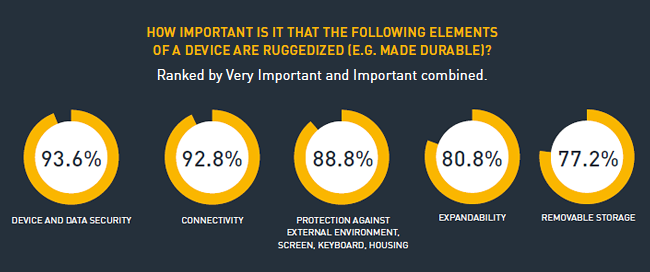
With an increasing number of manufacturers adding a wide range of rugged-sounding names and classifications to their computing devices, extreme terms are being thrown around like confetti in a bid to sway buyers. So what’s the real rugged news? And how can you be sure you’re buying technology that’s tough enough for your demands?
Rugged Confusion: Advice For Buyers Of Rugged Mobile Computing Devices (PDF 1MB), a recent study conducted by Opinion Matters and commissioned by Panasonic, will provide more clarity and show you what to look for when making your next technology purchase.
Rugged Standards Aren’t Really Standard

Buyers of rugged mobile computing devices are confused by the terminology describing just how tough their notebooks, tablets and handheld devices are. The report by Opinion Matters found 85% of business buyers of mobile computing devices believe standards for ruggedness are already in place – and yet none exist. Given that 88% of respondents said the ruggedness of their notebooks, tablets and handheld devices was very or fairly important to them when considering new purchases for their workforce, this confusion can lead to some very costly mistakes.
Confusion Abounds Over Rugged Terminology

Many buyers recognised common rugged terms but when it came to proving their understanding of these terms, the majority failed miserably. Less than half of buyers were aware of Ingress Protection (IP) Ratings and two-thirds were unable to correctly identify that the rating was for protection against particles and liquid and the higher the rating the better the protection. 69% of buyers believed or expected the terms “MIL-STD compliant” and “tested to MIL-STD” to be a consistent measurement – when they are not. Buyers were also wildly confused by what was covered in the commonly quoted US Military Standard 810G, with more than 35% of respondents incorrectly believing it applied to battery life.
In reality, MIL-STD-810 is a series of lab tests designed by the U.S military to test equipment limits in various environmental conditions where it is expected to be used. There is a wide range of conditions covered by the standard but common commercial tests include exposing the device to shock or drop, dust, water and extreme temperatures.
Buyers Show Reliance on Manufacturer Claims

To add to the risk, 20% of buyers confirmed that they do not undertake any tests of their own when buying devices and simply believe the manufacturers’ claims. As a result, we would recommend all buyers examine the manufacturers’ claims very closely; ask to see test details and certificates. Examine whether the testing was undertaken independently or even under laboratory conditions and then test the products themselves, in the field, with a thorough pilot evaluation before buying.
Priorities Changing for Rugged Device Buyers

The research also showed that the business requirements for rugged devices were also evolving from the traditional environmental concerns of withstanding drops and water and dust protection. When asked which elements of the device were most important to be ruggedised, buyers put device and data security at the top of the list with 94% ranking it very important or important. Devices that are just tough no longer meet the need. Buyers need manufacturers of their rugged devices to have considered important issues such as the type of viewing screen, battery life and power management and the security of data and the device’s communications capabilities.
Toughbook Tips for Your Next Rugged Purchase

A well-chosen rugged mobile computing device can deliver a transformation in workforce productivity and be a practical and useful tool for the user – providing a long-term return on investment. Based on this research, we’ve put together a handy checklist for business buyers of rugged mobile computing devices.
ALWAYS ASK YOUR VENDOR:
- To supply MIL-STD 810G and IP certificates to support any testing or standards claims.
- How their products are engineered to offer light weight without compromising ruggedness or durability.
- If the Military Standard tests have been carried out on one single unit or if they used multiple units to fulfil the tests.
- Which display options their devices support.
- For a device with a high capacity battery option and exchangeable design to improve TCO and ROI.
- Which ports and interfaces are included in the main unit without adapter cables.
- How they support seamless data transfer and the latest connectivity standards.
- How they optimise power management on their devices.
COMPUTER PRODUCT SOLUTIONS WHITEPAPERS:
Take a look at our full range of exclusive computer product solutions whitepapers.
Contact us
Contact us for more information on Panasonic Business products:.



